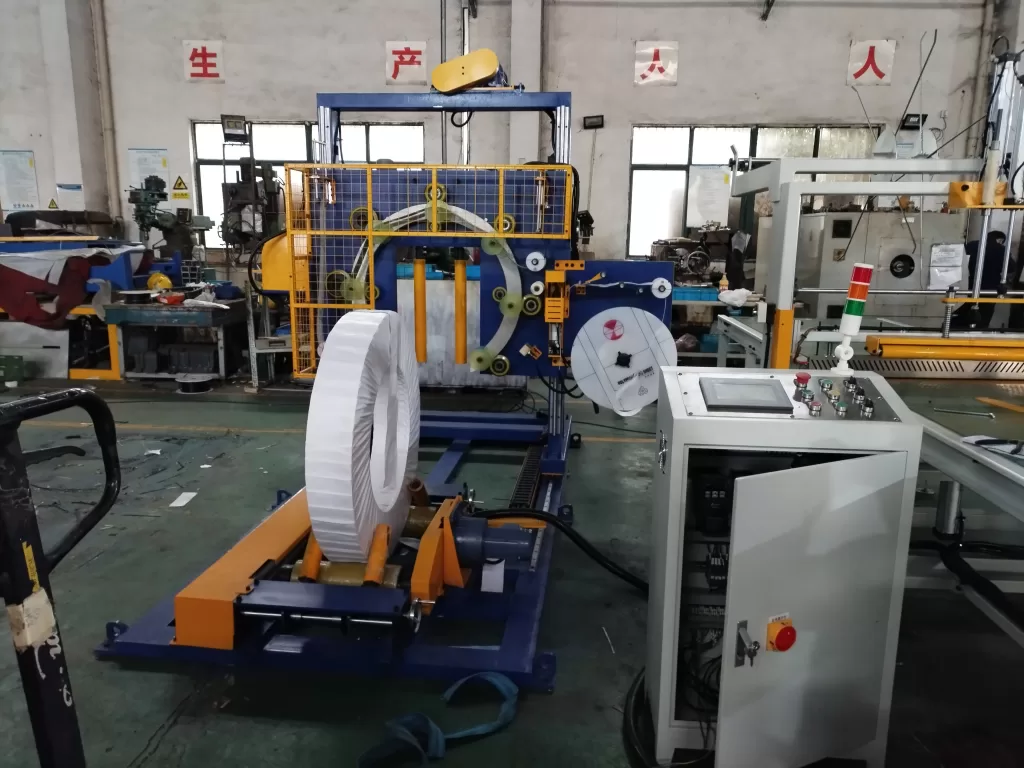Mastering Coil Packaging: Tension Control for Small Coils on Large Machines
Handling a diverse range of coil sizes is a common requirement in many industrial settings. While ideally, you'd use machinery perfectly sized for each coil, practical considerations like cost and floor space often lead to a single, larger coil packing machine designed to accommodate the biggest coils while also handling smaller ones.
For instance, a machine might need to handle coils with these specifications:
- Outer Diameter (OD): 600mm - 1800mm
- Width: 200mm - 800mm
- Inner Diameter (ID): 508mm - 610mm
In this scenario, the machine is typically engineered for the maximum dimensions (OD 1800mm, Width 800mm) but must remain compatible with the minimum dimensions (OD 600mm, Width 200mm). However, using a large machine for significantly smaller coils introduces a specific challenge: maintaining consistent and optimal packing material tension.

1. The Challenge: Eccentricity and Poor Tension Control
When a large wrapping machine processes a much smaller coil, a significant difference arises between the machine's rotational center and the coil's center. This eccentricity can lead to inconsistent application of the wrapping material (like stretch film or paper).
What happens? The wrapping material might become too slack in some parts of the rotation and too tight in others. This often results in:
- Wrinkled or creased packaging material on the coil surface.
- Insufficiently secured packaging, potentially leading to damage during handling or transit.
- Uneven protection against environmental factors.
This video demonstrates the issue: a large machine (designed for OD:1400mm) wrapping a smaller coil (OD:700mm) with stretch film. Notice the wrinkling on the coil surface due to uncontrolled tension caused by eccentricity.
2. The Rationale: Why Use Oversized Machines?
Despite the tension control challenge, opting for a single large machine offers compelling advantages:
- Higher Flexibility: A single machine can process the entire required range of coil sizes, eliminating the need for multiple dedicated machines.
- Lower Capital Cost: Investing in one large, versatile machine is often more cost-effective than purchasing several smaller units.
- Reduced Floor Space: One machine generally occupies less total footprint than multiple machines.
- Simplified Operation: Training operators and managing changeovers becomes easier with a single system.
- Streamlined Maintenance & Spares: Managing maintenance schedules and spare parts inventory is less complex.
The key is to mitigate the inherent drawbacks, primarily the potential for poor tension control when handling smaller coils.
3. Strategies for Effective Tension Control
Fortunately, advanced features can be incorporated into large coil packing machines to specifically address the tension problems caused by eccentricity when wrapping small coils.
3.1. Solution: Drawing Back Device
A "Drawing Back Device" is a mechanism engineered to compensate for the orbital path differences when wrapping smaller coils on a large machine. It actively adjusts the position or feed of the wrapping material shuttle relative to the coil, ensuring the material is applied smoothly and evenly despite the size mismatch.
This video shows testing of a large machine (designed for OD:1500mm) successfully wrapping a small coil (OD:650mm). Thanks to the drawing back mechanism, the package surface is smooth, indicating proper tension control.
3.2. Solution: Belt Tension Controller
Another effective solution involves a dedicated Belt Tension Controller. This system precisely manages the tension of the wrapping material (be it stretch film, paper, or VCI paper) as it's fed onto the coil. It can dynamically adjust the tension throughout the wrapping cycle, ensuring consistency from the beginning to the end of the process, regardless of the coil size relative to the machine's capacity.
This video illustrates an OD:700mm steel coil being wrapped with paper. The belt tension controller effectively maintains optimal tension, resulting in a smooth, secure package.
4. Conclusion: Achieving Versatility Without Compromise
While the principle "big machine for big coil, small machine for small coil" holds merit for ideal wrapping quality, practical and economic factors often necessitate using large coil packing machines for a wide range of sizes, including smaller ones. The primary challenge in such scenarios is maintaining consistent wrapping tension due to eccentricity.
By incorporating advanced features like Drawing Back Devices and Belt Tension Controllers, manufacturers can overcome these challenges. These technologies ensure that even when wrapping small coils on large machines, the packaging integrity is maintained, providing a smooth, tightly secured wrap. This allows businesses to leverage the cost, space, and flexibility benefits of a single, large machine without significantly compromising on packaging quality for their smaller products. Proper machine specification and incorporating these tension control solutions are key to achieving efficient and effective coil packaging across diverse production requirements.